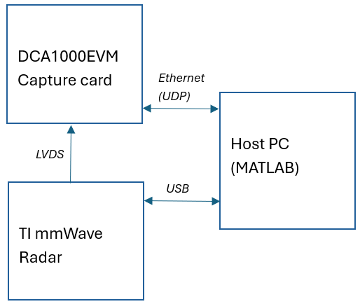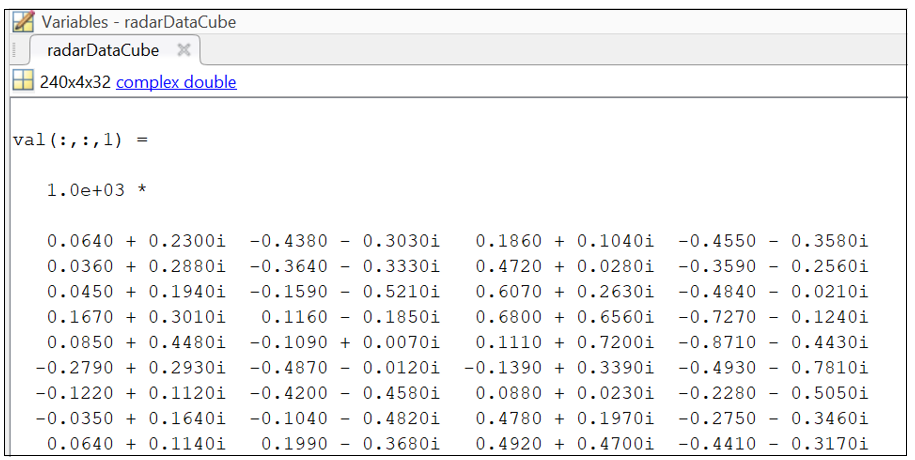dca1000
Connect to TI mmWave radar sensor and DCA1000EVM to capture raw ADC data for live processing or offline processing
Since R2024b
Description
The
dca1000
System object™ connects to a Texas Instruments® (TI) DCA1000EVM capture card that allows you to receive ADC Data (IQ Data )
from TI mmWave radar. You can use the object to read ADC data for real-time processing or
record the ADC data for processing at a later time.
The following image shows a simple connection diagram between host PC, DCA1000EVM and TI mmWave radar.

The Hardware Setup window in the support package guides you to make the hardware
connection and complete the other required setup. To run Hardware Setup, execute mmWaveRadarSetup
(this is a one time setup). After the hardware setup, to receive ADC (IQ) data from the TI
mmWave radar:
Create the
dca1000object and set its properties.To read one radar data cube for real time processing, call the object as if it were a function.
To record ADC data to a file in a host PC, call the
startRecordingfunction of the object.
Creation
Description
connects to a TI mmWave radar sensor specified by iqDataSource = dca1000(boardname)boardname and
DCA1000EVM capture card. The TI mmWave radar sensor and DCA1000EVM capture card are
connected to the host computer's serial port and Ethernet port, respectively. The
iqDataSource connection object has default property values. When
you use this syntax, MATLAB® automatically detects the serial port at which the TI mmWave radar
sensor is connected. Use this syntax when only one TI mmWave radar sensor is
connected to the host computer.
sets Properties using one or more
name-value arguments. iqDataSource = dca1000(boardname,Name=Value)
For example, iqDataSource = dca1000("IWR6843ISK",ConfigFile=
"C:\Users\User1\PrototypeV3\configMaxRangResolution.cfg") connects to
the DCA1000EVM that is connected to a IWR6843ISK radar board (with both boards
connected to your host computer), and prepares for reading raw ADC data by using the
configuration specified in the file configMaxRangResolution.cfg in
the specified path.
Input Arguments
Name-Value Arguments
Properties
Usage
Syntax
Description
reads
one radar data cube for live processing of raw ADC (IQ) data from the TI mmWave
radar sensor using DCA1000EVM. System objects may be called directly like a
function instead of using the step method. For example, y = step(obj) and y =
obj() are equivalent.iqData = iqDataSource()
Output Arguments
Object Functions
To use an object function, specify the
System object™ as the first input argument. For
example, to release system resources of a System object named obj, use
this syntax:
release(obj)
Examples
Read ADC radar data cube from TI mmWave Radar using DCA1000EVM
Connect to a DCA1000EVM, which is connected to a TI IWR6843ISK mmWave radar. If you
are using the function for the first time, make sure to run hardware setup process
(execute mmWaveRadarSetup command and follow the steps displayed in
the screens). Ensure that you have completed the required hardware connections and that
the network connection associated with DCA1000EVM is configured with the static IP
192.168.33.30. The detailed steps for this are also explained in
the Hardware Setup process.
Create a dca1000 object specifying the TI mmWave radar board
name.
boardName = "IWR6843ISK";
iqDataSource = dca1000(boardName)
iqDataSource =
dca1000 with properties:
BoardName: "IWR6843ISK"
ConfigPort: "COM6"
HostIPAddress: "192.168.33.30"
UDPPacketDelay: 25 (us)
ConfigFile: "C:\ProgramData\MATLAB\SupportPackages\R2024bPrerelease\toolbox\
target\supportpackages\timmwaveradar\configfiles\xwr68xx-IQDataStreaming.cfg"
Recording Properties
RecordLocation: "C:\ProgramData\MATLAB\dca1000Data"
RecordFilePrefix: "iqData"
RecordDuration: 10 (s)
MaxFileSize: 1024 (MB)
Show all properties all functions
Call iqDataSource object to read one sample of IQ radar data cube
from the TI mmWave Radar using DCA1000EVM.
% Read one radar data cube from the TI Radar % connected with the capture card DCA1000 EVM radarDataCube = iqDataSource();
radarDataCube is a complex double-precision three-dimensional
array of size SamplesPerChirp * NumRecievers * NumChirps.

Version History
Introduced in R2024b